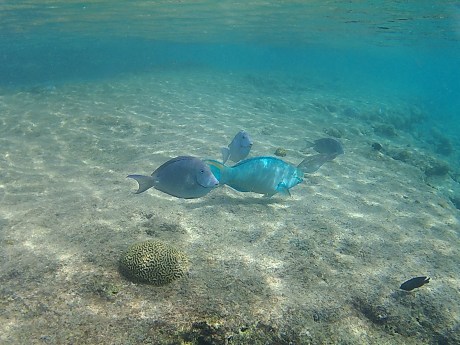
Fish captured with Colin’s underwater camera.
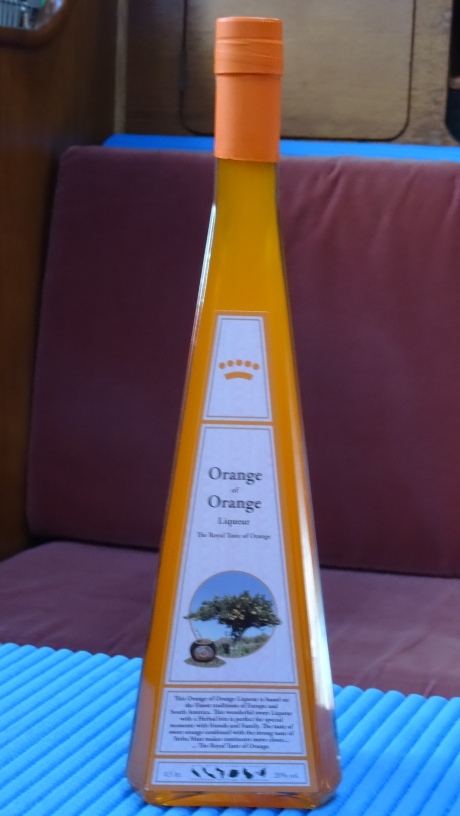
Orange cadushy liquor.
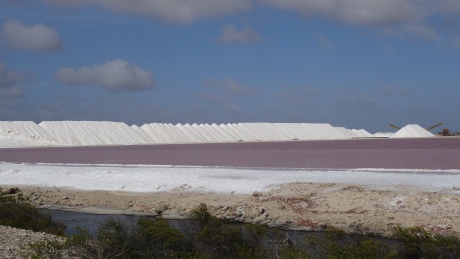
The pink salt pond…..with mounds of salt beyond.
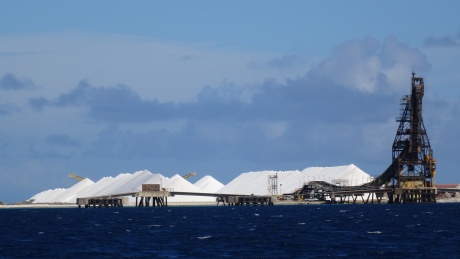
Mountains of salt ready for shipment.
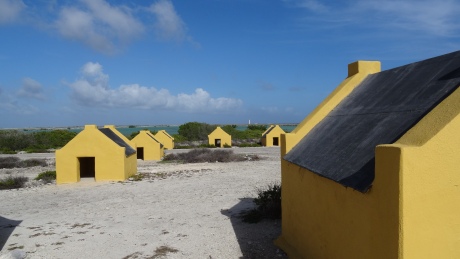
The shockingly tiny slave huts near the salt ponds, Bonaire.
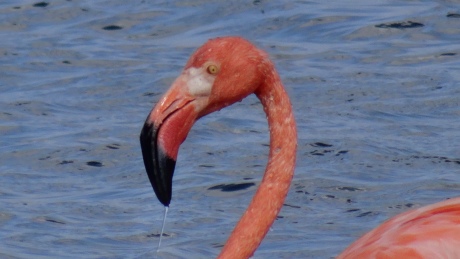
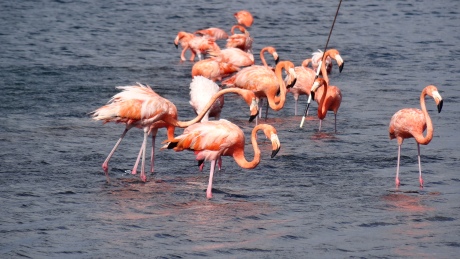
Flamingos!
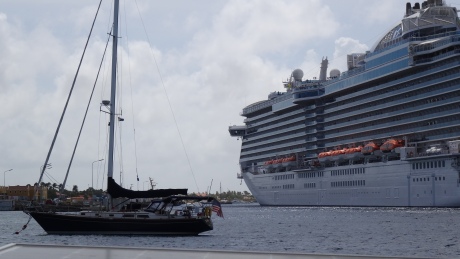
The daily cruise ships coming a bit too close for comfort to our anchorage.
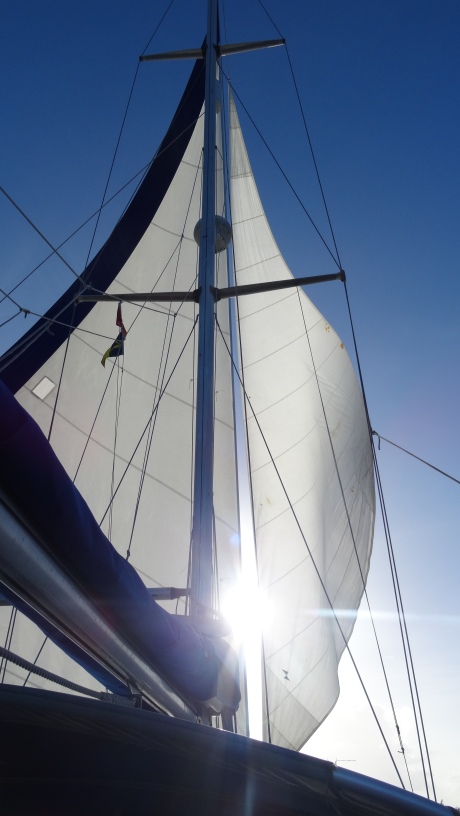
Twin headsails….speeding us downwind.
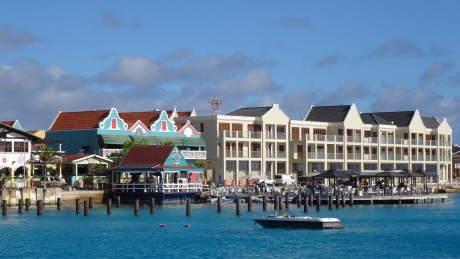
Kralendijk waterfront, Bonaire – from our anchorage.

Venezuelan islands in the distance….out of bounds.
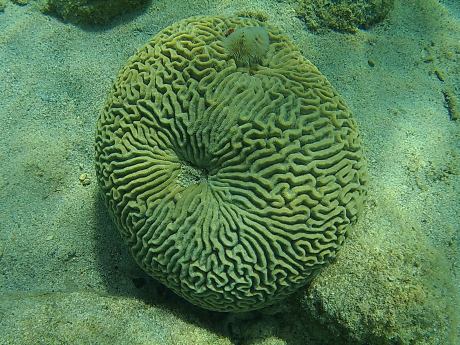
Brain coral
Never give up ground to windward”.
This is the maxim of every sensible sailor in the West Indies. Let me explain.
Unless you are a boy racer adrenalin junkie who loves their sailing to be (literally) on the edge, fast and furious, with the maximum tweaking of sails, the most sedately civilised point of sail is to have the wind to a lesser or greater extent, behind you. The boat then stays fairly upright (if a bit waddley); the wind stays fairly consistent thus minimising the fiddling with sails – in fact often only the headsail is required at all to make satisfying progress. It is called ‘sailing free’ and that is exactly what it usually is: free from stress, free from anxiety that you will actually make your chosen destination without having to tack backwards and forwards.
Here in the Caribbean though, the free sailing always comes at a price. The trade winds always blow from the east here. To have the wind behind you, to be able to relax and sail free means you are heading west. There will always be a pay-back time when you have to head east again risking some boy-racer style sailing…..thus, never give up ground to windward lightly.
So, you may well ask…..why have we just spent 4 days coming west from Trinidad to Bonaire? You are right it is probably completely bonkers, but the ABC islands (Aruba, Bonaire and Curacoa) have been billed as completely different from the other Caribbean islands; a refreshing change; out of the hurricane zone; and reassuringly, solidly….Dutch. Would this be enough, we wondered as we luxuriated in such a long downwind passage with our twin headsail rig (reminiscent of our Atlantic crossing in fact) to give up all this ground? We would undoubtedly have to go east again at some point in the future to head back into the Caribbean proper. We can only hope we do not live to regret our rash decision!
Our four day passage from Trinidad took us directly along the Venezuelan coast. In not many years gone by, a sailor would have casually stopped along the way at enticing, iconic islands like Margarita, Tortuga and the allegedly stunning reefs of Los Roques, but with the economy of Venezuela hitting rock bottom and the resulting desperation and deprivation causing the crime rate to soar, these former idylls are now sadly just too risky and therefore out of bounds to cruisers. Thus we kept a sharp watch and remained well off shore – somewhat relieved at seeing hardly a soul on our journey. The further west we sailed the cooler it became. What a relief to leave behind the tropical, humid steam of Trinidad! Yes, it was hot, but the lower humidity made it feel so much more comfortable.
The other persuader for us throwing caution to the easterly winds was our friends. Several of our much more experienced Ocean Cruising Club friends were already in the ABC’s extolling the virtues of these very different islands. Choices of venues are limited when it comes to safe havens in the hurricane season from the end of May until the end of November but the ABC’s are safely outside of the hurricane zone – not having had a hurricane for a century or so. Couple this with their European heritage; it is easy to see why these islands are beloved by risk-averse boat insurance companies. Our friends have taken full advantage of this over many hurricane seasons and were eager for us to join them as soon as we came back to Resolute from our mostly, marvellously manic 3 month sojourn in the UK. They were literally leading us astray…..we were content to be led to pastures new.
We really did not have much idea what Bonaire would be like. It is difficult to imagine a Caribbean island without the all invasive vivid gaudiness of African culture. Here, we understood, despite a shaming history of blatant slave importation and labour, today there was more of a South American influence. So perhaps it would remind us more of our time in British Guyana or the neighbouring former Dutch Suriname?
We had kept in radio contact (initially SSB radio but as we got within range the VHF) with our friends already in Kralendijk, Bonaire. It was no surprise to them then, after about 76 hours sailing from Trinidad, when we eventually came round the low headland towards them in the broad sheltered bay. We had been told that as the island was so low (so Dutch!) we would not see it until we were virtually on top of it. Nonetheless, it was quite disconcerting after so many days at sea, to not have the satisfaction of seeing your quarry until a few miles away. We had been used to spying vast volcanic edifices way out to sea…but not so with diminutive, reefy, Bonaire. The highest point is only just over 100 metres. Having the conservation of its coral reefs firmly in the forefront of the highly ecologically-attuned Dutch minds, there were carefully spaced mooring buoys in the bay at Kralendijk. Damaging anchoring is strictly forbidden. Thankfully our friends had found us a free buoy and helped us onto it. After four days doing four hourly watches we were very relieved to have any help offered and desperate for a full night’s sleep again.
Tackling first the necessary formalities the next day we began to get a sense of Bonaire. Our brand new dinghy with its protective synthetic doormat floor covering (soon dubbed ‘the Axminster’) took us round the massive cruise ship terminal to a designated dinghy dock near the modern, red-roofed customs and immigration building. Here we cleared in with the absolute minimum of fuss and bother, assisted (yes, assisted!) by amiable, efficient, smart-looking, English speaking, officials. This was definitely not the Caribbean we were used to. Rather incongruously, our next stop was to draw some dollars from an ATM. Bonaire, being a very popular tourist destination especially with hoards from almost daily cruise ships, decided about five years ago to ditch the traditional guilders, forsake the euro and adopt the US dollar. So much easier for the international tourist and supposedly for commerce too. Those, sensible, savvy Dutch. Armed with our dollars we explored the town of Kralendijk. As to be expected of such a popular tourist destination there were many shops selling souvenirs of varying quality and taste. Amongst all these though there was a bakers, numerous bars, restaurants and cafes, a large supermarket with a Chinese flavour, a chandlers – in fact everything we could need in a small compact town….including of course bike-hire…..the proper Dutch sit-up-and-beg bikes so reminiscent of Holland. We soon learned that slightly out of town there was a larger Dutch supermarket with foods direct from the Netherlands….tempting indeed.
How come these little Dutch islands exist so far away from home? In the late 15th century the conquistadors, having shipped the indigenous Caiquetios to Hispanola to work for them, decided the islands were far too dry for any meaningful development and the Spanish then abandoned their claim to the islands. Along came the Dutch West India Company in the early 1600’s and managed to set up some plantations. By the time the trade in slaves was flourishing, the ABC’s provided a training base for domestic and farm labour from which the slaves were resold throughout the Caribbean and Americas. Today, Bonaire’s main sources of income are from tourism (which without the threat of hurricanes is all-year-round) and salt. The salt lakes with their incumbent flamboyant flamingos dominate the otherwise sandy, cacti-strewn scrublands with huge piles of white salt ready to be loaded onto ships at a purpose-built dockside.
The history of Bonaire is noticeable in Kralendijk in the architecture. Typical Dutch-colonial merchant’s houses still exist on the waterfront with their raised front porches and gabled roofs. Even the more modern buildings maintain echoes of the original styles. As you wander the streets though what is not so typically Dutch is the language. It is a strange mix of so many tongues and called Papiamento and apparently derives from several African dialects as well as a smattering of Spanish, Portuguese and Dutch – a melange that is still reflected in the multiplicity of faces and skin-tones. Thank goodness everyone seems to speak good English too.
The focus of the tourist industry in Bonaire is the crystal clear water which forms the Marine Park around its shores. The coral reefs have long been carefully preserved and consequently house a huge variety of tropical fish, rays and other marine life. It is heaven for divers and snorkelers alike. Colin had his new underwater camera (his birthday present) at the ready.
After several days recovering from our trip, being wined and dined, seeing the new 007 film (‘Spectre’) in a nearby open-air cinema and exploring Kraneldijk on foot, it was time to go further afield, so with some friends we hired a car. As soon as we drove out of town the rough roads gave way to cacti and sandy scrub. Snaking along the coast road the arrid inland view is uninspiring but the glimpses of the ocean are incredible with the stunning azure waters lapping the shores and crashing against the rocky foreshore. We passed a little farmstead which announced it was a distillery of a particular cactus (known locally as cadushy). Needless to say we stopped and had a tour of this small but very industrious family-run business. It was fascinating to hear about the process of extracting the goodness from the otherwise unattractive, prickly and un-yielding cadushy. They flavoured the distilled alcohol with various other fruits and herbs. Being Dutch of course, the most popular flavour was orange…..a bottle of which had to be purchased after liberal sampling just to ensure we both approved! Even the rum they made from the cadushy had a very distinctive flavour……..and believe me we are now the sommeliers of the rum-tasting game!
Onward in our little Kia car to Rincon – eleven miles northwest of Kralendijk – which is the oldest town on the island and has a distinctly dusty, wild-west aura about it. It was apparently founded by the Spanish late in the 1500’s as an inland haven safely hidden from view from any pirates, though there was little evidence of the old town today so we found no reason to stop. As we drove, iguanas darted across the dusty roads in front of us and donkeys and goats littered the road sides. It was difficult to believe that in this parched landscape there had indeed been flourishing plantations but obviously not of the more water-dependent coffee, cocoa and sugar variety we had become used to seeing in the West Indies. Here grew acres of divi-divi trees, for their pods were a valuable source of tannin used to tan hides. Alongside were fields of aloe plants, the sap of which was used as a laxative and the basis for cosmetics and soothing creams. Climbing any gradient was a novelty on this trip so we could not resist the turning to the spot height viewing point. There was a huge, imposing cross on the highest peak (all 123 metres of it) built for the millennium, from where the views were spectacular. The piece de resistance of our trip appeared as we rounded a corner looking down on a huge lake. What looked like little orangey pink dots on the lake surface soon came into focus as flamingos…..dozens of them. What a sight to behold! Extraordinarily tall, gauche but elegant birds dressed in gaudy pinkness strutted, preened and bickered in the sunshine, seemingly oblivious to the constant stream of human admirers clicking their cameras relentlessly.
The other side of the island was given over to watersports and salt. In the touqouise waters protected by the vast reef we took a refreshing dip and then lunched by the beach watching cool (mostly) young ‘dudes’ wooshing along with great skill and balance aboard their wind-surfboards. Then completing our loop round the island we passed the massive salt lakes which varied in hue from tea-coloured to pink. Flamingos were here too – but by this time we were quite blasé about them. Dotting the waterfront between the salt lakes and the sea were little white stone huts. These, we read from the information post were rather salient reminders of the cruelty and abuse of our fellow human beings in times past. Each tiny dwelling provided a sleeping space on the floor for up to six slaves who worked in the salt production and shipping business.
With the convenience of a large boot and easy transportation we finally pulled into the large Dutch supermarket ….to be met with the likes of which we had not seen since leaving UK. Wow! Huge, clean, air-conditioned, well-stocked with all sorts of delights ……so, so civilised! Don’t you just love the Dutch for just putting all that decadent Waitrose-esqueness right in our path. Even with our list to hand it was impossible to stay on piste! Our bank account still bears the scars of all our indiscretions. It was yet another reason why so many cruisers stay so long in Bonaire.
